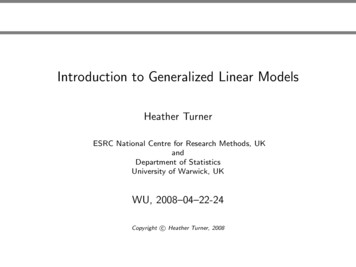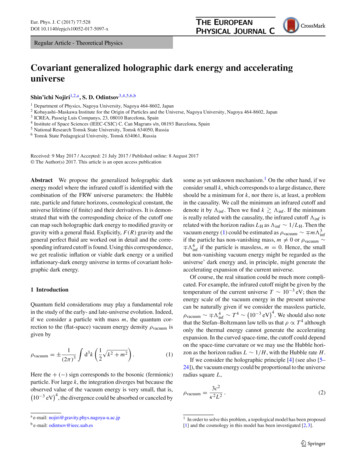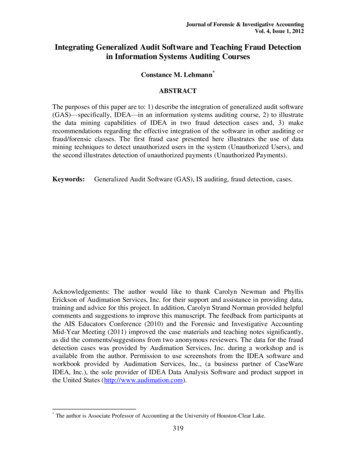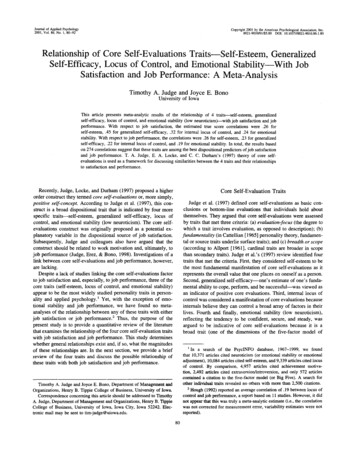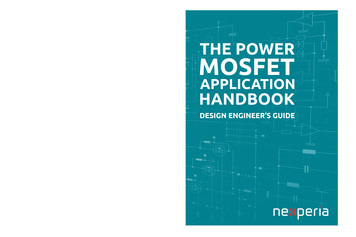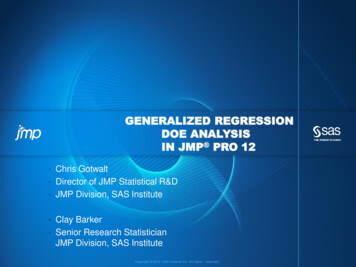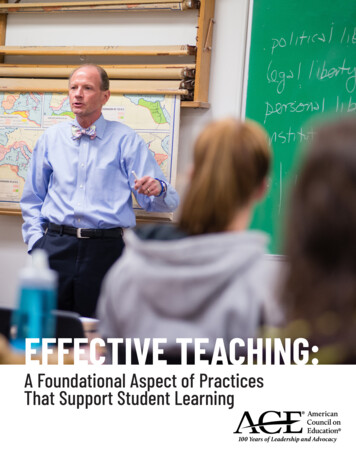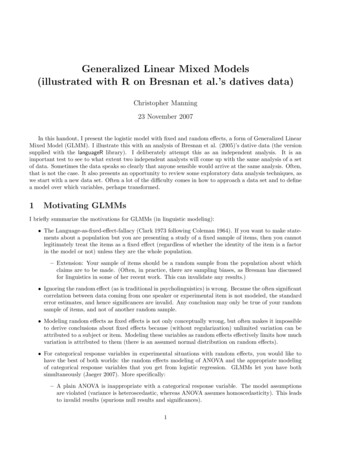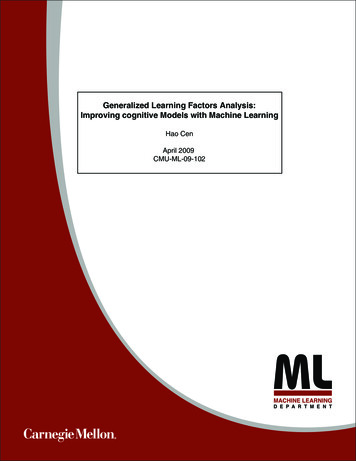
Transcription
Generalized Learning Factors Analysis:Improving cognitive Models with Machine LearningHao CenApril 2009CMU-ML-09-102
Generalized Learning Factors Analysis:Improving Cognitive Modelswith Machine LearningHao CenApril 2008CMU-ML-09-102Machine Learning DepartmentSchool of Computer ScienceCarnegie Mellon UniversityPittsburgh, PennsylvaniaThesis Committee:Kenneth Koedinger, ChairBrian JunkerGeoff GordonNoel Walkington, Mathematical SciencesSubmitted in partial fulfillment of the requirementsfor the degree of Doctor of Philosophy.Copyright 2009 Hao CenThis research was sponsored by the Department of Energy under contract no. R305B070487, the Department ofEducation under contract no. R305K030140, the Department of Energy (WPI) under contract no. 0821622001,and the National Science Foundation (PSLC) under contract no. SBE-0354420. The views and conclusionscontained in this document are those of the author and should not be interpreted as representing the officialpolicies, either expressed or implied, of any sponsoring institution, the U.S. government or any other entity.
Keywords: cognitive models, intelligent tutoring systems, machine learning,educational data mining, learning factors, psychometrics, additive factor models,latent variable models, exponential principal component analysis, logistic regression,combinatorial searchii
To my parentsand to my wifeiii
CONTENTSGeneralized Learning Factors Analysis: Improving Cognitive Models with MachineLearning. iLIST OF TABLES. viiLIST OF FIGURES . ixACKNOWLEDGMENT . xiABSTRACT . xiii1. Introduction. 11.1The Challenge of Evaluating and Improving Cognitive Models . 11.2Research Questions and Thesis Overview . 21.2.1Research Questions . 31.2.2Thesis Organization . 32. Related Work . 52.1Cognitive Psychology . 52.2Psychometrics . 62.3Machine Learning and Data Mining . 63. Learning Factors Analysis – The Static Part . 93.1The Q-Matrix . 93.2The Additive Factor Model (AFM) . 93.3The conjunctive factor model (CFM) . 103.4Parameter estimation. 113.4.1.1 Maximum Likelihood Estimation . 113.4.1.2 Penalized Maximum Likelihood Estimation . 123.5Assessment of the Statistical Models. 123.6Assessment of the Cognitive models . 133.7Example of AFM -- Geometry Area . 13iv
3.83.7.1Applying AFM . 133.7.2Comparing two cognitive models . 14Comparing AFM and CFM. 154. Learning Factors Analysis – The Dynamic Part. 174.1The P-Matrix . 174.2Model operators . 174.3Model search . 194.4Example of the Search – Simulated Data. 204.5Example of the Search – Geometry Learning Data . 245. Applications of LFA . 275.1Other Researchers’ Use of LFA. 275.2Improving Student Learning Efficiency by Reducing Over Practice . 275.2.1Discover Learning Inefficiency through AFM . 275.2.2Saving Student Learning Time while Maintaining Learning Gains . 296. Automatic Discovery of Q Matrices with EPCA . 316.1Principal Component Analysis (PCA) and Exponential-Family PrincipalComponent Analysis (EPCA) . 316.2Application of EPCA for Automatic Discovery of Q Matrices . 316.2.1Formulation 1 . 326.2.2Formulation 2 . 326.2.3Formulation 3 . 336.2.4Formulation 4 . 336.3Complications of applying EPCA to real data . 346.4Evaluation of EPCA – the Fold-in Algorithm. 346.5Connections between AFM and EPCA. 356.6Results . 366.6.1Simulated Data . 36v
6.6.26.7Real Assessment Data . 39Thoughts on MLE and Full Bayesian Modeling for EPCA. 437. Conclusions and Future Work . 468. Appendix. 478.1The derivation of the log likelihood function of AFM . 478.2The derivation of the log likelihood function of CFM. 488.3The Factors in the P matrix for the Geometry Data . 498.4The Factors in the P matrix for the EAPS Data . 508.5Alternative Q matrices found by LFA search using CFM . 509. Bibliography . 51vi
LIST OF TABLESTable 1 Examples of the skills in a cognitive model . 2Table 2 Comparing LFA with other approaches. . 8Table 3 A sample Q-matrix . 9Table 4 Skills and predicted probability for three algebra items. 10Table 5 A list of skills used in the initial cognitive model of the Geometry Tutor . 13Table 6. The sample data . 14Table 7. Statistics for a partial list of the skills, students and the overall model.Intercept for skill is the initial difficulty level for each skill. Slope is thelearning rate. Avg Practice Opportunties is the average amount of practice perskill across all students. Initial Probabltiy is the estimated probability of gettinga problem correct in the first opportunity to use a skill accross all students. AvgProbability and Final Probability are the success probability to use a skill at theaverage amount of opportunities and the last opportunity, respectively. . 14Table 8 Two cognitive models under comparison. The skills changed are highlighted.The arrows show the directions of change of the skills. 15Table 9 Statistics of two cognitive models . 15Table 10 Model comparison of the simulated data. β (.1, .5, .9).in probability.AFM-P stands for fitting the AFM with penalized MLE. CFM-P stands forfitting the CFM with penalized MLE. . 16Table 11 Skill coding used in this paper. 16Table 12 A sample of the Q-matrix in the EAPS data. 16Table 13 Model comparison of the EAPS data. . 16Table 14 A Q-matrix. 17Table 15 A P-matrix . 17Table 16 Adding column “neg” in P to Q. 17Table 17 Merging “Add” and “Sub” in Q . 18Table 18 Splitting “Sub” in Q by “neg” in P . 18Table 19 Model statistics after a split . 19Table 20 The true Q matrix used to generated the data. 21vii
Table 21 The P matrix . 21Table 22 Training errors and cross validation errors for the true Q matrix. 22Table 23 LFA Search result 1 – the skills sets contained in the best, 2nd best, the 3rdbest models found by LFA. Lamda is the penalty parameter. . 23Table 24. BICs for the true Q matrix and for the top three Q matrices found by LFA. . 23Table 25 Cross validation scores for the true Q matrix and for the top Q matricesfound by LFA when lamda equals 1. 24Table 26. Factors for the geoemtry data . 25Table 27. Top three improved models found by LFA with BIC as the heuristic. . 25Table 28. Top three improved models found by LFA with BIC as the heuristic. . 26Table 29 Knowledge tracing parameters used in the 1997 Cognitive Geometry Tutor . 28Table 30 Time cost in the six tutor curriculum units. The time is in minutes. . 30Table 31 Two Q matrices from EPCA on the same data. 38Table 32 The lists of skills along with their parameter estimates from the best three Qmatrices found by LFA search with penalized AFM on the EAPS data, rankedby BIC. The cross validation errors of the three models are listed in the last row. 41Table 33 A part of the best Q matrix found by LFA search on the EAPS data. 42Table 34 The lists of skills along with their parameter estimates from the best three Qmatrices found by LFA search with penalized CFM on the EAPS data, rankedby BIC. The cross validation errors of the three models are listed in the last row. 50viii
LIST OF FIGURESFigure 1 A graphical representation of student responses on items. The questionmark represents the latent skills that determine student performance. . 3Figure 2 A power law learning curve . 5Figure 3 A learning curve with blips (left) split into two smoother learning curves(right). 6Figure 4 Item response model. 7Figure 5 Single latent variable response model . 7Figure 6 Cognitive model . 7Figure 7 A best-first search through the cognitive model space . 20Figure 8 Training errors and cross validation errors for the true Q matrix . 22Figure 9 BICs for the true Q matrix and for the top three Q matrices found by LFA. 23Figure 10 Training and cross validation error rates for the true Q matrix and for thetop Q matrices found by LFA on the simulated data when lamda equals 1 . 24Figure 11 Learning Curve of Rectangle-Area and Trapezoid-Area – The solid linesare the actual error rates over the ordered number of practices. The dotted linesare the error rates predicted by LFA. 28Figure 12 Pretest and post test scores over the two conditions (left) and the retentiontest scores (right). 29Figure 13 Percentage of Time Saved. 30Figure 14 Cross validation errors, training errors and their standard errors. Eachcurve is plotted as a function of the number of latent skills. The solid line is forthe mean cross validation errors and the dotted line is for the training error. Onestandard error bars are imposed on each error curve. The top left, top right, tomiddle left, middle right, bottom left and bottom left plots have theregularization parameters lamda for 0, .2, .4, .6. ,8. 1. . 37Figure 15 The error rates for the best Q matrices found by EPCA and LFA. In eachgroup, the left bar is for EPCA and the right bar is for LFA. 38Figure 16 Cross validation errors, training errors and their standard errors by EPCAon the EAPS data. Each curve is plotted as a function of the number of latentix
skills. The solid line is for the mean cross validation errors and the dotted line isfor the training error. One standard error bars are imposed on each error curve.Lamda is the regularization parameter. . 40Figure 17 Scatter plot of the values of the V matrix found by EPCA when theregularization parameter equals 1 and the number of skills equals 2. The itemsare labeled with different numbers. . 42Figure 18 The error rates for the best Q matrices found by EPCA and LFA for thereal assessment data set. In each group, the left bar is for EPCA and the rightbar is for LFA. . 43Figure 19 the MAP estimate (the red line) and a sample of the posterior distribution(the green lines) from the Irises data set. 44Figure 20 the plate view of the graphic model representation of EPCA withhierarchical priors . 44x
ACKNOWLEDGMENT[1]An ant, viewed as a behavioral system, is quite simple. The apparent complexity of itsbehavior over time is largely a reflection of the complexity of environment in which itfinds itself.Herbert SimonWhile watching ants wandering across the boulders on a beach, we may wonderwhat determines the complex behavior of those ants. Is it from the complexity of theenvironment or from the complexity of the ants? Nobel Laureate Herbert Simonargued that the cognitive and the physical capacity of ants are tiny compared withmighty nature and it was more from the complexity of the environment in hisacclaimed book The Sciences of the Artificial [2]. He went on to explain how humanproblem solving was similar in the sense that the complexity of the problem largelydetermines the human problem solving process. He even wrote another paragraphexactly the same as the quote in the beginning except that “an ant” was replaced by“a man”.What if the ants have a map of the beach? Knowing where the boulders are andwhere food may possibly lie may tremendously help the ants reach their goal. Buthow do they get such a map? Limited by its cognitive capacity, a single ant may beable to explore a small piece of the beach. While many ants explore some pieces ofthe beach, some may go faster and some may go slow. Some may get stuck by bigboulders and some may get low hanging fruits quickly. The aggregate pattern of theirexploration all together may provide hints of a beach, like where the obstacles areand where a flat terrain lies.xi
In the scope of this thesis, the ants are our students. The beach is the problemdomain they are exploring, such as math and sciences. This thesis is our attempt toprovide a method to find a more accurate map of the problem domain. Blessed withthe increasing availability of student learning data and armed with the state-of-artmachine learning tools, we can now stand five thousand miles above on the beachand have the telescope to study richly recorded ants’ paths. The map starts to emergeand we then make it more accurate by learning from data.I would like many people who have helped and supported my path to thecompletion of the research and my Ph.D. My college mentors Chunbai Zhang andHuiqiang Ge, and my graduate school mentors at UT Austin Susan Williams, PaulResta, and Min Liu, prepared my early training for the endeavor. The Datashop team– Alida Stogsholm, Ben Billings, Kyle Cunningham, Brett Leber, and Sandi Demi –have provided me support on storing and acquiring data. Ajit Singh has providedessential help on the machine learning tool we used. Steve Ritter, John Steinhart, andChristy McGuire at Carnegie Learning have provided numerous support onCognitive Tutor.My committee member Brian Junker, Geoff Gordon, Noel Walkington, eachfrom unique perspective, shaped my research into solid forms, teaching me how todraw strengths from different fields. My advisor Kenneth Koedinger has beenmentoring me in the past five years. From him, I learned what is meant to bepassionate for a field for life with an ultimate goal to benefit mankind, which isengraved in my heart.I am in debt to my wife Ting Chen and my parents. With them, my happiness isdoubled and sadness is halved.xii
ABSTRACTIn this thesis, we propose a machine learning based framework called LearningFactors Analysis (LFA) to address the problem of discovering a better cognitivemodel from student learning data. This problem has both significant real worldimpact and high academic interest. A cognitive model is a binary matrixrepresentation of how students solve domain problems. It is the key component ofCognitive Tutors, an award-winning computer-based math curriculum that grows outof the extensive research in artificial intelligence at Carnegie Mellon. However,discovering a better matrix representation is a structure learning problem ofuncovering the hidden layer of a multi-layer probabilistic graphic model with allvariables being discrete.The LFA framework we developed takes an innovative machine learningprocess that brings human expertise into the discovery loop. It addresses fourresearch questions that one builds upon its predecessor. Accordingly, four techniquesare developed to solve each problem.The first question is how to represent and evaluate a cognitive model. Webrought in the concept of Q-matrix from Psychometrics and developed a pair oflatent variable models – Additive Factor Model and Conjunctive Factor model -- thatpredict student performance by student prior knowledge, task difficulty and tasklearning rates.The second question is how to bring human expertise into the discovery of thelatent skill variables. We introduced a technique for subject experts labeling latentfactors and developed three graph operators – add, merge and split to incorporate thelatent factors in the existing graphical structure.The third question is how to improve a cognitive model given extensive humanlabeling. We introduced the concept of P-matrix and developed a penalizedcombinatorial search built on top of the latent variable models. The searchmechanism semi-automatically improves existing cognitive models by “smartly”choosing features from the P-matrix and incorporating them into the Q-matrix. Thepenalty imposed on the search criteria helps to avoid over fitting the data.The fourth question is how to automate the latent variable discovery processwithout human involvement. We used Exponential Principal Component Analysisthat decomposes student-task matrix into a student-skill matrix and a skill-itemmatrix. We then compared its performance with LFA.At the end of the thesis, we discuss several applications of LFA to improvestudent learning. We applied LFA to student learning data and used an LFAimproved cognitive model to save students 10% - 30% learning time across severalunits in a curriculum without hurting their learning performance. The company thatmarkets Cognitive Tutor has started to use improved cognitive models for the 2008version of the products onward. The estimated timesaving for all U.S. students whoare using the Tutor is more than two million hours per year in total.xiii
1. Introduction1.1 The Challenge of Evaluating and Improving Cognitive ModelsOf all the initiatives to improve the math level of U.S. students, vastly improving K12 math education has been a top priority. One major development toward this end isIntelligent Tutoring Systems. The technology that drives intelligent tutoring systems isgrounded in research into artificial intelligence and cognitive psychology, which seeks tounderstand the mechanisms that underlie human thought, including language processing,mathematical reasoning, learning, and memory. As students attempt to solve problemsusing these tutoring systems, the programs analyze their strengths and weaknesses andon that basis provide individualized instruction. Intelligent tutoring systems do notreplace teachers. Rather, they allow teachers to devote more one-on-one time to eachstudent, and to work with students of varying abilities simultaneously. They allowteachers to design assignments targeted to individual student needs, thereby increasingstudent advancement.A primary example of Intelligent Tutoring Systems helping U.S. children learnmath is Cognitive Tutors, an award-winning computer-based math program that growsout of the extensive research in human learning and artificial intelligence at CarnegieMellon. Evidence indicates that students using the Cognitive Tutors program perform30% better on questions from the TIMSS assessment, 85% better on assessments ofcomplex mathematical problem solving and thinking, and attain 15-25% higher scoreson the SAT and Iowa Algebra Aptitude Test. The equivalent learning results hold forboth minority and non-minority students [3-5]. By 2007, more than 500,000 middleschool students began using Cognitive Tutors across the United States.The full potential of ITS has not yet been reached, though. The issues mainlyconcern the efficiency level of the cognitive models used, which is at the heart of mosttutoring programs. These models describe a set of math skills that represent howstudents solve math problems.With cognitive models, ITS assesses student knowledge systematically andpresents curricula tailored to individual skill levels and generates appropriate feedbackfor students and teachers. An incorrect representation of the domain skills may lead toerroneous curriculum design and negatively affect student motivation. An inaccuratemodel may waste limited student learning time, and teacher instructional energies, bothof which are vital to full achievement. According to Carnegie Learning, teachersreported that many students could not complete the tutor curriculum on time. This issueis serious. First, if students cannot complete the cognitive tutor curriculum, they arelikely to fall behind their peers. Second, schools today are calling for increasedinstruction time to ensure adequate yearly progress. The reality, however, is thatstudents have a limited amount of total available learning time, and teachers have arestricted amount of instructional time. Saving one hour of instructional time can be farmore productive than increasing instruction by the same amount. This saved time doesnot reduce student or teacher workloads, but simply makes better use of the energy andattention given to this subject, thus allowing for greater devotion to other academicareas, thus increasing performance in those subjects. The learning gain may beremarkable.Getting the appropriate cognitive model is challenging because:
1) There are hundreds of skills involved in a single sub-domain of math. Forexample, the middle school geometry curriculum is estimated to have over 200individual skills.2) Many math skills are not explicitly stated in textbooks, and textbook authorsoften expect students to acquire those skills via problem solving.3) Skill is not directly observable. The mastering of a skill can only be inferredfrom student performance on tasks that require those skills.4) Initial cognitive models were written by math experts. Many prior studies incognitive psychology have shown that experts often make false predictionsabout what causes difficulty for students due to “expert blind spots” [6-13]The existing cognitive models are usually an incomplete representation of studentknowledge, resulting in both less accurate assessment of student knowledge and lowerstudent learning efficiency than desired. Improving the existing cognitive models, giventhe rate at which the Cognitive Tutor is used across the U.S., has an immediate andsignificant impact on student learning, and has a long-term impact on transforming mathcurriculum design. Now, an increasing number of student learning data is becomingavailable. Within the Pittsburgh Science of Learning Center, a central education datawarehouse has hosted over 50 student learning data sets ranging from the domain ofalgebra to foreign language learning. The challenge, then, is how do we get a bettercognitive model using student learning data?1.2 Research Questions and Thesis OverviewA cognitive model is a set of production rules or skills encoded in intelligent tutorsto model how students solve problems. (Production, skill, and rule are usedinterchangeably in this paper.) Productions embody the knowledge that students aretrying to acquire, and allows the tutor to estimate each student’s learning of each skill asthe student works through the exercises. For example, the following table shows threeskills used in the Area unit of a geometry tutor.Table 1 Examples of the skills in a cognitive modelSkill nameSkill meaningCircle-areaGiven the radius , find the area of a circleCircle-circumferenceGiven the diameter, find the circumference of a circleCircle-diameterGiven the radius or circumference, find the diameter of a circle.The properties of the skills in a cognitive model contribute to a student’sperformance on solving items that require those skills. Figure 1 shows a visualrepresentation of several items. On the right hand side are the items. Each item hasresponses as 1 for correct and 0 for incorrect.2
Figure 1 A graphical representation of student responses on items. The question mark represents the latent skills thatdetermine student performance.Discovering the set of skills can be formulated as a structure learning problem ofuncovering the hidden layer of a multi-layer probabilistic graphic model with allvariables being discrete. Unlike many standard machine learning problems with the goalof accurate prediction at the end, a unique requirement of this problem is that the skillsdiscovered in the cognitive model need to be interpretable to human beings. After all,these models are used to explain and trace student mastery. Both students and teachersneed to be able to understand what the weaknesses and strengths of a student’s masteryof a subject. Tutor authors need to understand the skill labels to be able to authortargeted items and hint messages. Being able to communicate the meaning of thediscovered skills to humans is a crucial step for it to be useful. The unique side of theLearning Factors An
Generalized Learning Factors Analysis: Improving Cognitive Models with Machine Learning Hao Cen April 2008 CMU-ML-09-102 Machine Learning Department School of Computer Science Carnegie Mellon University Pittsburgh, Pennsylvania Thesis Committee: Kenneth Koedinger, Chair Brian Junker Geoff Gordon Noel Walkington, Mathematical Sciences
